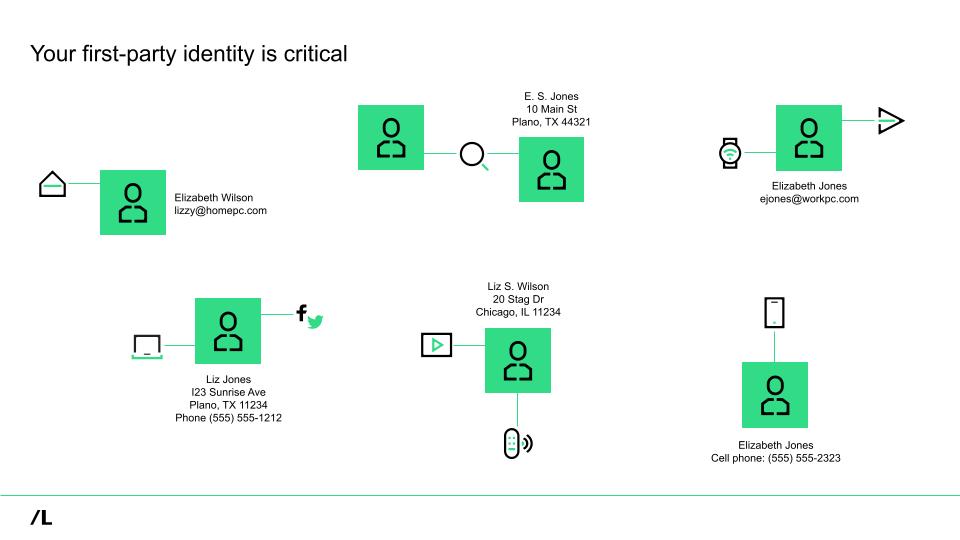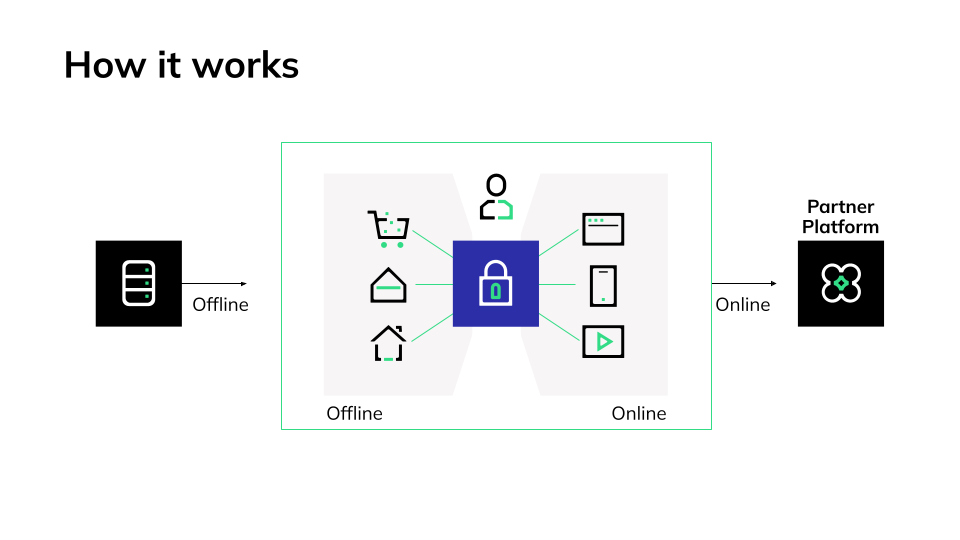What is first-party data?
You’ve probably seen the term “first-party data” before, but if you’re new to marketing or the advertising industry (or if you just need a refresher), you may be unfamiliar with what “first-party” means exactly.
First-party data is from a company’s customers and is collected with their explicit permission. The company can use this data to develop strategies, experiences, and campaigns catering to their ideal customer’s wants and needs.
As this is the good stuff, the richest source of insight into your ideal customer, it should technically be the easiest to learn from and activate. But if you can’t tie the data in all your siloed systems—like your marketing platforms, customer relation management tools (CRMs), point of sale (POS) systems, enterprise resource planning tools (ERPs), contact center databases, etc.—back to single customer records, it’s not all that useful.
Here’s an example of a person who has moved, uses multiple email addresses, and changed her name. All of this first-party data about Elizabeth/Liz may be somewhere in your system, but without the ability to bring it all together safely, securely, and accurately, you may be inadvertently offering her a disjointed customer experience.

How is first-party data collected?
There are several ways you can capture first-party data. Here are few examples:
Methods of first-party data collection
- Email: Nurture campaigns and email subscription newsletters represent a low investment in terms of level of effort for your audience and provide a direct avenue to build engagement with them. Through sending emails, you can gather data like open rates, bounce rates, and click-through rates and run specific campaigns targeted to varying levels of interest.
- Website: Your website is often the most widely used method to collect first-party data. Where it makes sense, you can request information from folks who visit your site (like names and email addresses) on your checkout page and gain key insights into customer transactions and behavior, such as how long they spend on a particular page.
- Apps: Customers who use your mobile app have already expressed the most sincere interest in your offerings since they’ve taken the time to download your app to their mobile device. Mobile app downloads can be leveraged to discern how interested a customer is in your brand.
- Purchase history: This data is also very useful for measurement and analysis: Brands can see what’s selling, what’s not, and where.
How can you start trusted first-party data relationships?
For marketers, there is nothing more meaningful than providing the personalized experiences consumers expect and welcome. However, companies can be so eager to deliver those unique experiences that they sometimes forget the goal is not just to simply extract information from their customers, but do so in the context of an established value exchange. Simply put, people need to know what’s in it for them. If you’ve done it right, a downstream result is robust first-party data and a deeper understanding of a customer—which can build your competitive advantage because this information is exclusive to you.
An equitable value exchange
The idea of “value exchanges over time” is not unlike the marketing funnel. Say you are a retailer. A consumer might click on one of your ads. They might visit your website. They like what they see and decide to follow you on social media. They might even like, comment, or retweet your content. If you have brick-and-mortar locations, they might stop in, peruse the aisles, and ask your salespeople questions. These would all be considered upper-funnel engagements that mark the beginning of your relationship. Every touch point matters. Marketing is not the only team that builds that relationship or trust.
If you want to deepen a first-party data relationship, you need to continue delivering valuable experiences across all interactions. Provide opportunities to move customers down the relationship funnel, such as allowing them to create wish lists for favorite items they enjoy. Perhaps it’s a newsletter, alerts when a favorite writer or topic is posted, or a text message when a coveted item is back in stock. Consider this mid-funnel—the point at which you can obtain an increased level of authentication or “hand-raising.” Continue to nurture the relationship by always creating value.
This is the question to ask: “How can I help this person with what they need?” It is not “How can I get this person to convert?”
Over time, the consumer will move into the bottom funnel and willingly provide a greater level of first-party data. At that point, they’re converting into a longer-term customer. For some companies, that might be the end game. For the leaders, it’s just the beginning in what you hope is an enduring, loyal relationship.
Privacy and regulations
Trust is the foundation of all relationships. To build trust with customers, all companies should be committed to ensuring personal data use is ethical and appropriate—not only within the confines of the law, but also with foresight that goes beyond compliance with legal or regulatory guidelines.
In fact, regulators acted on behalf of consumers and the GDPR in the EU was one of the first significant privacy regulations to take effect, which forced companies to change how they were handling consumer data. Since then, more regulatory bodies have followed suit—notable entrants include California’s CCPA and CPRA, Brazil’s LGPD, Japan’s amendments to APPI, and more. Additionally, tech leaders have taken a stand to show solidarity with consumers in order to instill loyalty and trust in their brand and experiences.
What is the difference between first-, second-, and third-party data?
While first-party data is considered the most valuable type of customer data, it’s not the only type. Below are a few more:
Second-party data
This is data that consumers provide to another company that—with the consumer’s notification and consent—you may access through a partnership agreement. Put another way, it’s someone else’s first-party data. For instance, you could enter into a collaborative data partnership with an airline to share loyalty card data to improve your targeting.
Third-party data
This is data that was collected on other sites, platforms, or offline by—you guessed it—a third party. Third-party data is used extensively by companies to better understand their audiences and to better target prospective customers. It’s great for demographic, contextual, and behavioral targeting if your core audience for a particular message or product is 24- to 36-year-old males who love wine but not cheese, for example.
Zero-party data
Forrester Research created this term to describe data that a customer proactively or voluntarily shares with a brand through social media, interactive quizzes, messages with customers through chatbots, etc. Zero-party data is valuable because it doesn’t require analysis and offers insights directly from customers.
Why does first-party data matter most?
While there are millions of different ways to go about marketing, we can all agree on one thing—it is always cheaper to retain customers than it is to acquire new customers. First-party data acts as the baseline for getting to know your customers because it comes from genuine engagement with your company across a wide variety of consumer touchpoints. When you connect the constellation of touchpoints per customer and multiply that by millions, you can easily see how powerful first-party data can become for your business as a whole.
Gain insight into how you and your cross-team peers all benefit from unified first-party data by watching our webinar Optimizing First-Party Identity Across the Enterprise.
Watch NowBenefits to getting your first-party data in order
To get your first-party data house in order, start by investing in an identity solution. This enables you to unify and consolidate your customer view, an ongoing challenge all industries face that is well worth continued investment for many use cases. Check out the chart below for some industry-specific customer benefits your brand can realize as you start to bring your first-party data together:
| Industry |
Benefit to customers |
| Retail |
More personalization |
| CPG |
Better service and experiences through direct relationships |
| Publisher |
More relevant ads and, eventually, better content and experiences |
| TV |
Personalized, multi-screen ad experience |
| Auto |
Cross-channel engagement before, during, and after a purchase |
| Energy |
Prevent an unhelpful/repeat ad experience |
Activating your first-party data

Your identity solution of choice should also help you activate your first-party data, engage with people at precisely the right moment with the right message, and have the ability to easily test and iterate across channels without a big commitment or investment into new platforms and formats. Leading identity solutions even do the hard work of integration for you to ensure your media strategy matches consumers’ ever-changing preferences, so you can remain privacy-centric and stay ahead of competitors.
The first step, however, is company buy-in. Your organization’s leadership should be aligned and fully support a digital transformation journey inclusive of connecting your disparate first-party data.
Next, conduct a data audit. Determine what data you already have and, more importantly, why you are collecting it. Earning useful data is a continuous process that has the ongoing goal of discovering what the customer wants from you.
Then use your identity solution to help you clean, resolve, enrich, and organize your first-party data so you can activate it across the customer journey.
Key marketing use cases for first-party data
Ad targeting
Targeting is one of the most powerful use cases for first-party data activation. It enables you to precisely engage your customers with the right message at the right time across their journey. You can accomplish things like activating offline customer records to target them via digital channels, or reach the same customer across multiple devices and channels at the right frequency with personalized ad messaging and creative.
Audience suppression
Through suppression, you are able to remove specific audience-based segments from online and offline marketing campaigns. Suppression enables tactics like removing customers who made a recent in-store purchase from online or offline campaigns or blocking high-risk prospects from viewing an insurance display advertising campaign.
Lookalike modeling
New modeling techniques like predictive modeling are being adopted to better analyze customers. Lookalike models help you reach new customers that look and behave like your high-value customers, increasing prospects in the pipeline and growing your business.
Audience enrichment is a powerful way to get in front of the right audience and boost ROI. If you’re new to augmenting your first-party data with second- and third-party data, check out the LiveRamp Data Marketplace.
Learn MoreUnlock new revenue streams with first-party data
Today, the need for companies to expand the use of first-party data across all customer experiences and create new revenue streams is stronger than ever. One way to achieve both of these aims is to explore launching a retail media network, which helps retailers and their suppliers better understand customers and deliver more welcome, relevant experiences. Understanding whether or not your data and channels are of value to others takes time. Each step, however, is necessary to increase the value of your first-party data, build customer intelligence, and eventually kick-start a new revenue stream.
Retail media networks are significant sources of revenue for today’s leading players. Forbes reported that Amazon sold $31.1 billion in ads on its platform in 2021, and Walmart disclosed that it sold $2.1 billion in ads in 2020.
Above all, a retail media network is about the connected experience with the customer at every touch point—whether in-store, online, or engaging with emails—and ensuring your brand meets shoppers’ and suppliers’ needs.
This ebook reveals key strategies to build a high-value media network that delivers differentiated value to partners, advertisers, platforms, the industry, and your customers.
Download NowThe future of first-party data
While using first-party data to market to known customers is not a new concept, the approach to doing so is constantly evolving. Marketers can now integrate all of a brand’s offline and online first-party data to reach and engage customers wherever they are in their journeys. As marketers increasingly adopt customer intelligence as a strategic discipline, brands are expecting more from their first-party data and are planning on increasing their use of first-party data in the years ahead.
Having a clear and executable first-party identity strategy is crucial for opening up more opportunities in the post-cookie, post-mobile ad ID world of evolving regulatory compliance. Brands need to get their efforts set up with an eye on managing their approach, today as well as into the future.
LiveRamp can help you build a lasting data strategy that helps you get closer to consumers and respect their privacy while driving more efficient advertising, better engagement, and higher customer retention.
Watch Now






